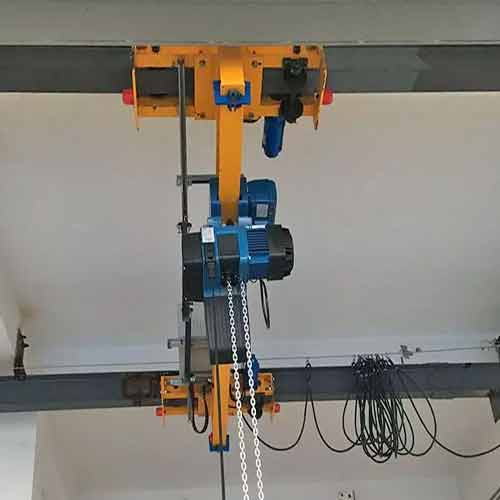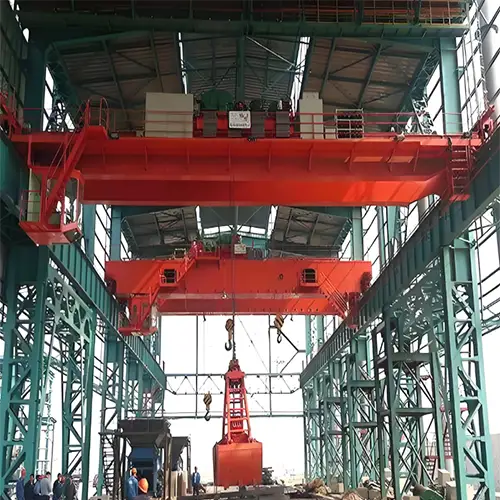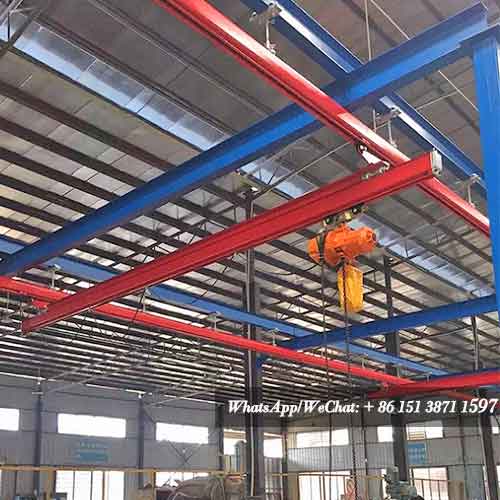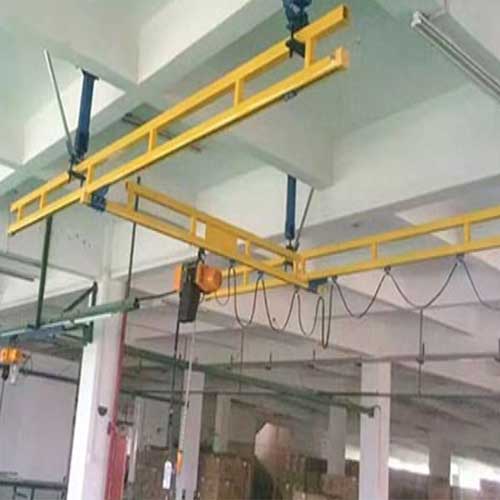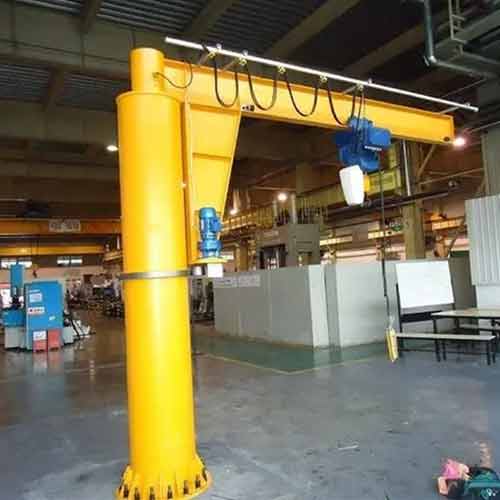Ceiling Crane System Guide:Ceiling Crane Types, Uses & Benefits
Ceiling crane for sale. Check overview on ceiling mounted crane systems, i.e., ceiling crane types, typical ceiling crane applications & benefits for you.
Category: Ceiling Mounted Crane
Your Trusted Overhead Crane Manufacturer & Supplier
Ceiling Crane System Guide:Ceiling Crane Types, Uses & Benefits
Ceiling crane for sale. Check overview on ceiling mounted crane systems, i.e., ceiling crane types, typical ceiling crane applications & benefits for you.
Ceiling Crane System Guide: All on Ceiling Crane Types, Applications, and Benefits
Ceiling cranes have become indispensable in various industrial settings, revolutionizing the way heavy materials are handled and moved within a workspace. In essence, a ceiling crane is a pivotal tool designed to streamline lifting and material handling processes. This comprehensive guide delves into the various types of ceiling cranes, their applications, and the substantial benefits they bring to industries.
Ceiling cranes, also known as overhead cranes or bridge cranes, are material-handling devices suspended from the ceiling. They consist of a horizontal beam (bridge) that travels along a runway system, supported by either end trucks or trolleys. The crane's lifting component, often a hoist, can move horizontally along the bridge, providing exceptional versatility in material handling.
Ceiling cranes play a pivotal role in enhancing efficiency, safety, and productivity within industrial environments. By enabling the seamless movement of heavy loads, these cranes contribute to streamlined manufacturing processes, reduced manual labor, and improved workplace safety. The ability to lift and transport materials with precision makes ceiling cranes an integral part of modern industrial operations.
Overview of Ceiling Crane Systems
Ceiling crane systems consist of several key components working in tandem to facilitate material handling. The primary components include the hoist mechanism, runway system, and control systems. The hoist mechanism is responsible for lifting and lowering the load, while the runway system provides the track for the crane's movement. Control systems, often equipped with remote capabilities, ensure seamless and safe crane operation.
Ceiling cranes come in various types, each tailored to specific applications and industries. In the following sections, we will explore these types in detail, examining their unique features, advantages, and applications in different industrial sectors. Whether it's a ceiling-mounted bridge crane, articulating jib crane, gantry crane, or jib crane, each type serves a distinct purpose, contributing to the overall efficiency of material handling processes.
Ceiling Mounted Bridge Crane
Ceiling Mounted Bridge Cranes, often referred to as overhead bridge cranes, are a cornerstone in material handling within large industrial spaces. Comprising a horizontal bridge that spans the width of the facility, these cranes are supported by end trucks or trolleys, allowing for seamless horizontal movement along the runway system. The lifting mechanism, usually a hoist, can be electrically or manually operate
The key components include the bridge, end trucks or trolleys, runway beams, and the hoist. The bridge serves as the horizontal beam spanning the workspace, while the end trucks or trolleys support and guide the crane along the runway system. Runway beams provide the track for the crane's movement, ensuring stability and precision. The hoist, mounted on the bridge, is responsible for lifting and lowering loads.
Ceiling-Mounted Bridge Cranes: Single Girder vs. Double Girder
Ceiling-mounted bridge cranes play a pivotal role in material handling applications, and the choice between a single girder and a double girder configuration depends on various factors, including load capacity, span, and operational requirements.
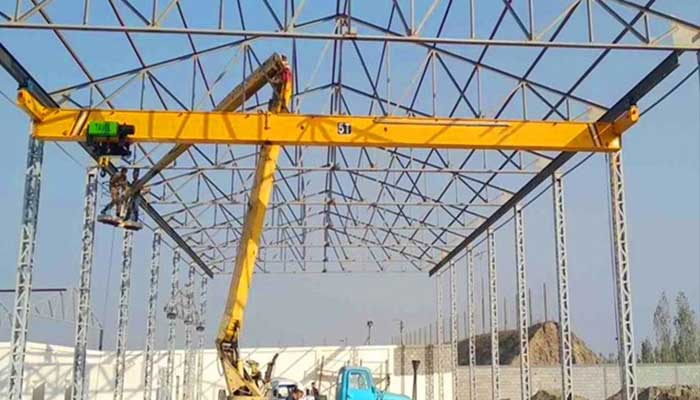
Single Girder Ceiling-Mounted Bridge Crane:
Design and Components:
- Single Main Beam: The single girder crane features a central main beam, providing a cost-effective and lightweight design.
- End Trucks: The end trucks house the wheels and mechanisms for smooth movement along the runway beams.
- Hoist and Trolley: Positioned beneath the girder, the hoist and trolley handle the lifting and lateral movement of the loa
Load Capacity and Span:
- Light to Moderate Loads: Suited for applications with light to moderate load requirements, typically up to 20 tons.
- Short to Medium Spans: Ideal for shorter to medium-span applications, making them versatile in various industrial settings.
Advantages:
- Cost-Effective: Single girder cranes are generally more cost-effective to manufacture and install.
- Ease of Installation: The lightweight design makes installation simpler and more straightforwar
- Versatility: Well-suited for facilities with lower headroom and space constraints.
Applications:
- Small Workshops: Ideal for smaller workshops or facilities with limited space.
- Light Manufacturing: Suited for applications with lighter manufacturing or assembly processes.
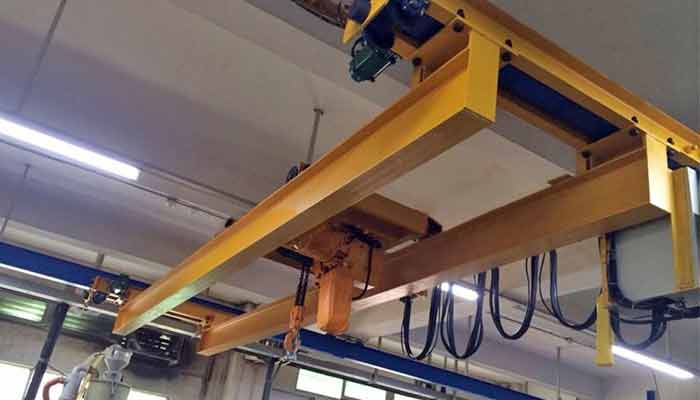
Double Girder Ceiling-Mounted Bridge Crane:
Design and Components:
- Two Parallel Girders: The double girder crane features two parallel girders connected by cross-bracing, providing increased stability.
- End Trucks: Similar to the single girder crane, end trucks support the crane's movement.
- Hoist and Trolley: Positioned between the two girders, the hoist and trolley offer enhanced lifting capacity and stability.
Load Capacity and Span:
- Heavier Loads: Designed to handle heavier loads, typically ranging from 20 to 500 tons.
- Longer Spans: Well-suited for longer spans, making them suitable for large manufacturing facilities and industrial operations.
Advantages:
- High Load Capacity: Double girder cranes offer superior load-bearing capabilities, making them suitable for heavy-duty applications.
- Increased Stability: The dual girder design provides enhanced stability, reducing deflection and sway during lifting operations.
- Wide Spans: Ideal for facilities with wide spans or those requiring the movement of heavy materials over longer distances.
Applications:
- Heavy Manufacturing: Suited for industries dealing with heavy steel, automotive, or machinery manufacturing.
- High-Capacity Warehousing: Ideal for warehouses handling oversized and heavy products.
- Shipbuilding and Construction: Commonly used in shipyards and construction sites for lifting and moving large components.
Considerations for Selection:
- Load Requirements: Determine the weight and dimensions of the loads to be lifte
- Span Length: Consider the distance the crane needs to travel for effective material handling.
- Headroom: Evaluate the available headroom in the facility for optimal crane installation.
- Budget Constraints: Assess budgetary considerations for crane acquisition and installation.
Selecting between a single girder and a double girder ceiling-mounted bridge crane depends on the specific needs and conditions of the industrial facility. Each configuration offers distinct advantages, and the choice should align with the operational demands, load requirements, and spatial constraints of the application.
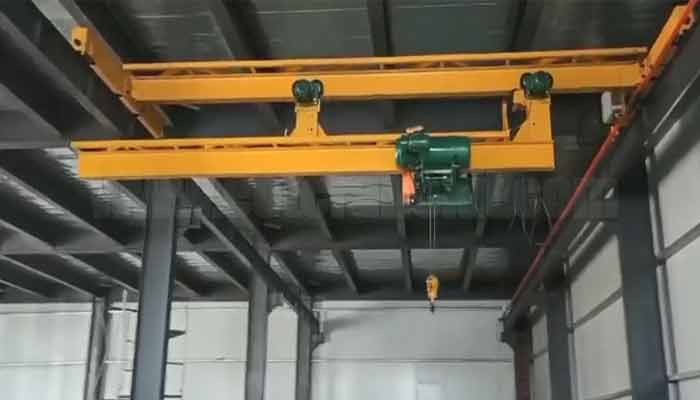
Ceiling Mounted Telescoping Bridge Top Running Overhead Crane:
- Components: Similar to the standard bridge crane but with telescoping capabilities.
- Design: Telescopic feature allows the horizontal bridge to extend or retract based on load requirements.
- Applications: Ideal for handling loads of varying sizes, providing enhanced flexibility in material handling processes.
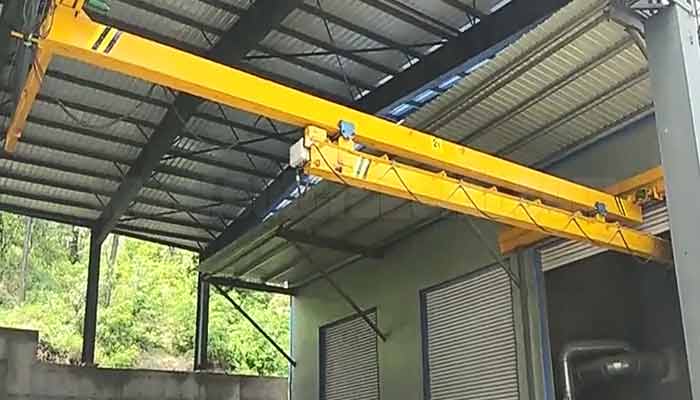
Ceiling Mounted Telescoping Bridge Underhung Running Overhead Crane:
- Components: Combines the features of a standard bridge crane with underhung design.
- Design: The bridge runs on the lower flange of the runway beams, maximizing available vertical space.
- Applications: Well-suited for facilities with limited headroom, allowing for efficient use of space in tight working environments.
Key Features and Advantages
Ceiling Mounted Bridge Cranes are characterized by their versatility and ability to cover large areas efficiently. Key features include a high lifting capacity, often ranging from a few tons to several hundred tons, making them ideal for heavy-duty lifting applications. The ability to traverse the entire length of a workspace facilitates efficient material handling and assembly processes.
Advantages of Ceiling Mounted Bridge Cranes include:
- High Load Capacity: Suitable for lifting heavy loads, making them indispensable in industries dealing with substantial materials.
- Precision and Control: The ability to move horizontally and vertically with precision allows for accurate placement of materials during manufacturing and assembly processes.
- Space Optimization: Since the crane is mounted on the ceiling, it doesn't occupy floor space, optimizing the working area and enabling better organization.
Applications in Industries (e.g., manufacturing, assembly)
Ceiling Mounted Bridge Cranes find extensive applications across various industries, significantly contributing to manufacturing and assembly processes. Industries benefiting from these cranes include:
- Manufacturing: Used for lifting, moving, and positioning heavy components on assembly lines, improving overall production efficiency.
- Assembly: Facilitates the seamless assembly of large products by precisely placing components in the required order.
- Automotive: Commonly employed in the automotive sector for tasks such as engine assembly and handling large vehicle components.
- Construction: Assists in lifting and placing construction materials, optimizing workflow on construction sites.
Ceiling Mounted Bridge Cranes, with their robust design and multifaceted capabilities, prove to be indispensable assets in industries where precision, efficiency, and safety are paramount.
Ceiling-Mounted Workstation Cranes: Standard vs. Aluminum
Ceiling-mounted workstation cranes provide efficient and ergonomic solutions for material handling in various industrial settings. The choice between standard workstation cranes and aluminum workstation cranes involves considerations related to load capacity, material construction, and the specific requirements of the working environment.
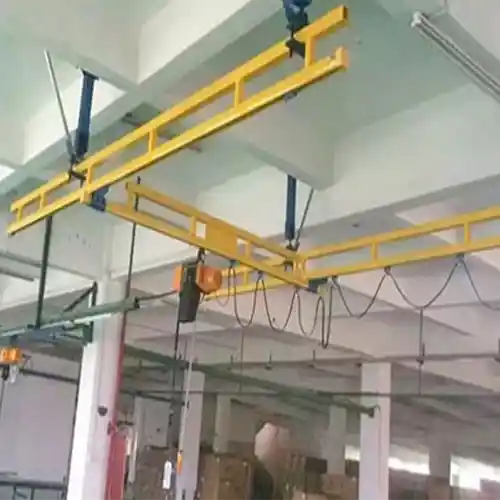
Ceiling-Mounted Workstation Crane (Standard):
Design and Components:
- Steel Construction: Standard workstation cranes are typically constructed with steel components, providing durability and strength.
- Trolleys and End Trucks: Equipped with trolleys and end trucks, allowing for smooth lateral movement along the runway system.
- Integrated Hoists: Standard workstation cranes come with integrated hoists that facilitate lifting and lowering operations.
Load Capacity and Span:
- Varied Load Capacities: Standard workstation cranes are available in various load capacities, catering to a wide range of material handling needs.
- Flexible Span Options: These cranes offer flexibility in span lengths, accommodating different workspace layouts.
Advantages:
- Robust Construction: Steel construction provides robustness, making standard workstation cranes suitable for heavy-duty applications.
- Versatility: Well-suited for versatile applications in manufacturing, assembly, and maintenance environments.
- Cost-Effective: Standard workstation cranes are often more cost-effective than specialized alternatives.
Applications:
- General Manufacturing: Ideal for general manufacturing environments requiring reliable and robust material handling.
- Assembly Lines: Suitable for assembly lines where frequent lifting and precise positioning are essential.
- Maintenance Workshops: Commonly used in maintenance workshops for various lifting tasks.
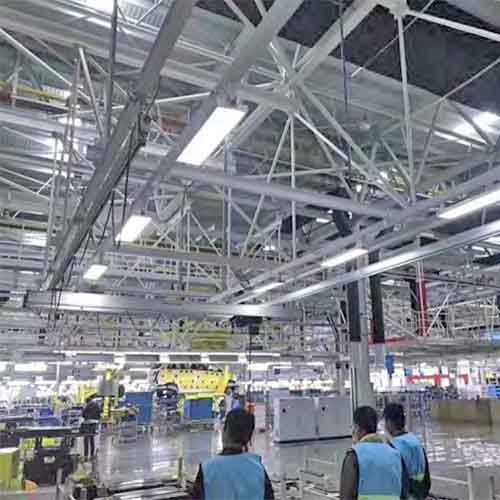
Ceiling-Mounted Aluminum Workstation Crane:
Design and Components:
- Aluminum Construction: Aluminum workstation cranes are constructed with lightweight aluminum components, offering ease of movement and installation.
- Integrated Hoists: Similar to standard cranes, aluminum workstation cranes come with integrated hoists for efficient lifting operations.
- Trolleys and End Trucks: Equipped with aluminum trolleys and end trucks, contributing to the overall lightweight design.
Load Capacity and Span:
- Light to Moderate Loads: Aluminum workstation cranes are designed for light to moderate loads, suitable for applications where heavy lifting is not require
- Short to Medium Spans: Well-suited for short to medium-span applications, providing flexibility in various work environments.
Advantages:
- Lightweight and Ergonomic: The use of aluminum makes these cranes lightweight and easy to maneuver, promoting ergonomic lifting practices.
- Corrosion Resistance: Aluminum offers corrosion resistance, making these cranes suitable for environments with exposure to moisture or chemicals.
- Quick Installation: Aluminum workstation cranes are designed for easy and quick installation, minimizing downtime during setup.
Applications:
- Workstations and Assembly Cells: Perfect for workstations and assembly cells where frequent and precise material handling is require
- Laboratory Environments: Commonly used in laboratory settings for delicate lifting tasks requiring precision.
- Applications with Limited Headroom: Aluminum cranes are beneficial in spaces with limited headroom due to their lightweight construction.
Considerations for Selection:
- Load Requirements: Assess the weight and dimensions of the loads to be lifte
- Workspace Layout: Consider the layout of the workspace to determine the most suitable crane configuration.
- Material Handling Frequency: Evaluate how frequently the crane will be used and whether manual or electric hoists are preferable.
- Installation Constraints: Consider the ease of installation and any specific constraints in the installation environment.
The choice between standard ceiling-mounted workstation cranes and aluminum workstation cranes depends on the specific material handling needs, budget considerations, and environmental factors within the workspace. Each type offers unique advantages, and selecting the appropriate crane ensures optimal efficiency and safety in material handling operations.
Comparison of Ceiling-Mounted Crane Systems: Bridge, Workstation, and Monorail
Ceiling-mounted crane systems, including bridge cranes, workstation cranes, and monorail cranes, each serve distinct purposes in material handling. Here's a comprehensive comparison of these systems based on key features, applications, and suitability for various industrial environments:
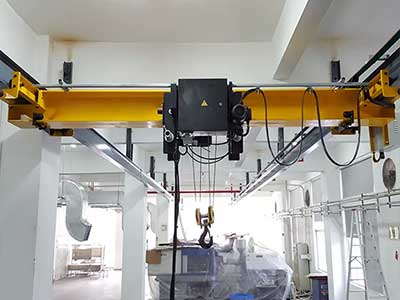
Ceiling-Mounted Bridge Crane System:
Key Features:
- Dual Girders: Typically features two parallel girders for enhanced stability and load-bearing capacity.
- Long Span Capability: Suitable for long spans between supports, providing flexibility in material movement.
- Heavy Load Capacity: Engineered for heavy-duty applications, often ranging from 1 to 500 tons.
Applications:
- Heavy Manufacturing: Ideal for heavy steel, automotive, or machinery manufacturing.
- High-Capacity Warehousing: Suitable for warehouses handling oversized and heavy products.
- Shipbuilding and Construction: Commonly used in shipyards and construction sites for lifting and moving large components.
Suitability:
- Heavy-Duty Operations: Best suited for applications requiring high load capacities and extensive material movement.
- Wide Span Requirements: Suitable for facilities with wide spans that demand efficient load transportation.
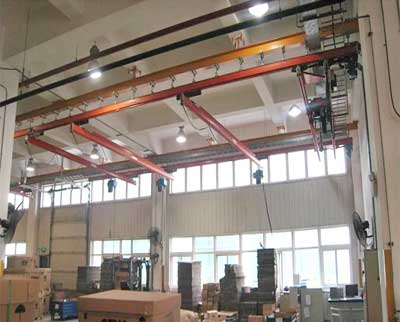
Ceiling-Mounted Workstation KBK Crane System:
Key Features:
- Single or Double Girder: Can be single or double girder, offering versatility in load capacity.
- Modular Design: Highly modular, allowing customization for specific workstations and applications.
- Lightweight Construction: Generally constructed with aluminum for ease of movement.
Applications:
- Workstations and Assembly Cells: Ideal for workstations and assembly cells where frequent and precise material handling is required.
- Maintenance Bays: Suitable for maintenance bays where tools and equipment need to be lifted and moved efficiently.
- Laboratory Environments: Commonly used in laboratory settings for delicate lifting tasks requiring precision.
Suitability:
- Ergonomic Material Handling: Suited for applications requiring precise and ergonomic material handling.
- Customizable Configurations: Ideal for facilities that need adaptable crane configurations based on specific workstation layouts.
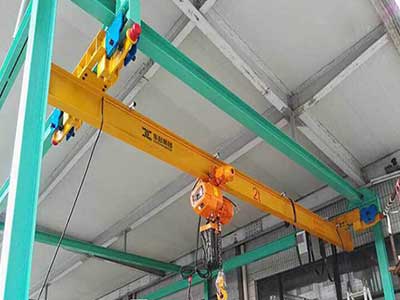
Ceiling-Mounted Monorail Crane System:
Key Features:
- Single Girder: Typically features a single girder, offering simplicity and cost-effectiveness.
- Straight or Curved Runways: Monorail systems can be designed for straight or curved runways, adapting to facility layouts.
- Versatility in Configurations: Offers flexibility in configurations, including interlocking systems for complex layouts.
Applications:
- Assembly Lines: Suitable for assembly lines requiring efficient material transport along a fixed path.
- Material Transport: Ideal for facilities where materials need to be moved from one point to another along a specific route.
- Limited Space Environments: Suited for spaces with limited headroom or confined layouts.
Suitability:
- Space Constraints: Best suited for environments with limited space where a fixed path for material transport is necessary.
- Simplified Material Flow: Suitable for applications that require a simplified and predictable material flow.
Comparison Summary:
| Criteria | Ceiling Mounted Bridge Crane | Ceiling Mounted Workstation Crane | Ceiling Mounted Monorail Crane |
|---|---|---|---|
| Load Capacity | High | Moderate to High | Moderate |
| Span Length | Long | Short to Medium | Short to Medium |
| Construction Material | Steel | Aluminum | Steel or Aluminum |
| Applications | Heavy Manufacturing, High-Capacity Warehousing | Workstations, Assembly Cells, Maintenance Bays | Assembly Lines, Material Transport |
| Versatility | Limited (Specialized for Heavy Loads) | Highly Versatile (Customizable Configurations) | Versatile (Adaptable to Various Layouts) |
| Installation Complexity | Moderate to High | Moderate | Moderate |
| Cost | Higher | Moderate | Moderate |
- Bridge Cranes: Best suited for heavy-duty operations with high load capacities and extensive material movement requirements.
- Workstation Cranes: Ideal for workstations, assembly cells, and maintenance bays where ergonomic and precise material handling is crucial.
- Monorail Cranes: Suited for environments with limited space or specific material transport paths, providing a simplified and predictable material flow.
Ultimately, the choice between these ceiling-mounted crane systems depends on the specific needs, space constraints, and material handling requirements of the industrial facility. Each system brings unique advantages, and selecting the right one ensures optimal efficiency and safety in material handling operations.
Ultimately, the choice between these ceiling-mounted crane systems depends on the specific needs, space constraints, and material handling requirements of the industrial facility. Each system brings unique advantages, and selecting the right one ensures optimal efficiency and safety in material handling operations.
Components of Ceiling Crane Systems
Hoist Mechanism
Types of Hoists (e.g., wire rope, chain):
- Wire Rope Hoists: Ideal for heavy-duty lifting, providing strength and durability.
- Chain Hoists: Versatile and suitable for a range of loads, with easy maintenance.
Load Capacity Considerations:
- Matching hoist capacity to the expected loads ensures safe and efficient lifting operations.
- Regular assessments of load requirements prevent overloading and ensure optimal performance.
Safety Features:
- Emergency braking systems for immediate halting in case of malfunctions.
- Overload protection to prevent strain on the hoist and ensure safe lifting operations.
Runway System
Track Configurations:
Single Girder:
- Cost-Effective Design: Single girder runway systems are known for their cost-effectiveness, making them a popular choice for facilities with budget considerations.
- Lighter Load Capacities: Ideal for applications with lighter loads, the single girder design provides a balance between functionality and affordability.
- Versatility: Well-suited for a variety of industrial settings, particularly where heavy loads are not the primary focus.
Double Girder:
- Enhanced Stability: The double girder configuration offers increased stability, making it suitable for applications requiring precision and higher load capacities.
- Heavy Load Handling: Designed to handle heavier loads, double girder systems are well-suited for industries dealing with substantial materials.
- Longer Spans: The dual girder design allows for longer spans between supports, providing flexibility in layout and material handling.
Box Girder Option:
- Structural Integrity: Some double girder runway systems feature a box girder design, enhancing structural integrity and load-bearing capabilities.
- Optimized Weight Distribution: The box girder design distributes loads more evenly, reducing stress on the structure and ensuring durability.
Crane Runway Configurations:
- Top Running: Both single and double girder configurations can be top running, where the crane wheels run on the top of the runway beams.
- Underhung: In underhung configurations, the crane wheels run on the bottom flange of the runway beams, providing flexibility in headroom.
Material Options:
Steel Runways:
- Durability: Steel is a robust material choice, providing durability and longevity, making it suitable for heavy-duty applications.
- Resistance to Wear: Resistant to wear and tear, steel runways maintain their structural integrity over extended periods of use.
Aluminum Runways:
- Lightweight: Aluminum is a lightweight material, making it suitable for applications where minimizing deadweight is crucial.
- Corrosion Resistance: Aluminum's corrosion resistance is beneficial in environments where exposure to moisture or chemicals is a concern.
Installation of Ceiling-Mounted Crane Runways
Steel Structure Ceiling Installation:
Structural Assessment:
- Conduct a thorough assessment of the existing steel structure ceiling to ensure it meets the load-bearing requirements of the crane system.
- Verify that the steel framework can withstand the additional load imposed by the crane and its operational capacities.
Anchor Point Installation:
- Install anchor points securely into the steel structure, providing a stable foundation for the crane runway system.
- Ensure proper alignment and spacing of anchor points to support the entire length of the runway.
Runway Beam Attachment:
- Affix the runway beams securely to the anchor points, ensuring proper alignment and levelness.
- Utilize appropriate fasteners and welding techniques to guarantee structural integrity and load-bearing capacity.
End Truck or Trolley Installation:
- Mount end trucks or trolleys onto the runway beams, ensuring smooth movement along the entire length of the crane system.
- Verify that the end trucks or trolleys are aligned correctly to prevent any deviations during crane operation.
Runway Alignment Check:
- Conduct a meticulous alignment check for the entire runway system to guarantee precision and smooth movement of the crane along the designated path.
- Adjust the runway beams as needed to achieve the required alignment.
Concrete Ceiling Structure Installation:
Structural Evaluation:
- Assess the structural capacity of the concrete ceiling to determine its ability to support the weight and dynamic loads imposed by the crane system.
- Ensure that the concrete is free from defects that could compromise its integrity.
Anchor Installation in Concrete:
- Drill and install anchor bolts securely into the concrete ceiling at specified intervals to create anchor points for the runway system.
- Use anchoring techniques suitable for concrete structures, ensuring a robust connection.
Runway Beam Mounting:
- Attach the runway beams onto the installed anchor points, securing them tightly to the concrete ceiling.
- Employ appropriate concrete anchors and fastening methods to withstand the forces exerted during crane operation.
End Truck or Trolley Placement:
- Mount end trucks or trolleys onto the runway beams, ensuring proper alignment and smooth movement.
- Verify that the end trucks or trolleys move seamlessly along the entire length of the crane system.
Alignment Verification:
- Perform a meticulous alignment check to confirm that the runway system is level, straight, and free from deviations.
- Make necessary adjustments to ensure optimal alignment for the safe and efficient operation of the ceiling-mounted crane.
Proper installation of ceiling-mounted crane runways is crucial for the safety and functionality of the entire crane system. Whether attaching to a steel or concrete ceiling structure, adherence to precise installation procedures ensures the reliability and longevity of the crane runway, contributing to the overall efficiency of material handling operations.
Maintenance Practices:
Regular Inspections:
- Check for Alignment: Regularly inspect the alignment of the runway beams to ensure that the crane operates smoothly along its path.
- Look for Wear and Tear: Identify any signs of wear, such as worn-out wheel flanges or damaged rail surfaces, and address them promptly.
Lubrication:
- Moving Parts: Ensure that all moving parts, including the crane wheels and runway joints, are adequately lubricated to minimize friction and wear.
- Preventive Maintenance: Implement a preventive maintenance schedule for lubrication to extend the lifespan of the runway system.
Repairs and Replacements:
- Address Issues Promptly: If any issues are identified during inspections, repairs or replacements should be addressed promptly to prevent disruptions in crane operation.
- Upgrades as Needed: Consider upgrades or modifications to the runway system based on changing load requirements or advancements in technology.
Choosing the right runway configuration and materials for a ceiling crane system is crucial for ensuring stability, load-bearing capacity, and overall longevity. Regular maintenance practices, including inspections, lubrication, and timely repairs, contribute to the reliable and efficient operation of the runway system.
Controls and Automation
Remote Control Options:
- Radio frequency or infrared remote controls for convenient and safe crane operation.
- Allows operators to maintain a safe distance from the load and optimize visibility.
Automated Systems for Efficiency:
- Programmable logic controllers (PLCs) for automated and precise crane movements.
- Integration with other automated processes for seamless material handling workflows.
Safety Measures in Control Systems:
- Collision avoidance systems to prevent accidents in shared workspaces.
- Emergency stop features for immediate halting in case of unforeseen circumstances.
Understanding and optimizing these components in a ceiling crane system ensures not only efficient material handling but also contributes significantly to workplace safety. Proper maintenance practices and the incorporation of advanced control and automation technologies further enhance the overall performance and longevity of ceiling crane systems.
Applications in Industrial Sectors
Manufacturing
Assembly Line Integration:
- Enhanced Workflow: Ceiling cranes seamlessly integrate into manufacturing assembly lines, optimizing the workflow by efficiently moving components to the required stations.
- Precision Placement: The precision of ceiling cranes ensures accurate positioning of components during assembly, minimizing errors and improving overall product quality.
- Time Efficiency: By streamlining the assembly process, these cranes contribute to shorter production cycles, enabling manufacturers to meet demanding deadlines.
Material Handling Efficiency:
- Heavy Load Capabilities: Ceiling cranes are equipped to handle heavy loads, enhancing the efficiency of material handling in manufacturing facilities.
- Reduced Manual Labor: Automation of material handling tasks reduces the need for manual labor, minimizing physical strain on workers and enhancing overall efficiency.
- Flexibility in Load Sizes: The adaptability of ceiling cranes to handle various load sizes improves the versatility of material handling processes in manufacturing.
Reduction in Production Downtime:
- Quick Load Movements: Ceiling cranes facilitate swift movements of materials, reducing the time required for loading and unloading.
- Minimized Waiting Times: The precise and rapid material placement contributes to the reduction of waiting times during the production process, minimizing production downtime.
- Continuous Operation: By minimizing manual interventions and streamlining processes, ceiling cranes contribute to a more continuous and uninterrupted manufacturing operation.
- Integration with Automation: Advanced ceiling crane systems integrate with automation technologies, further reducing the need for manual interventions and enhancing overall production efficiency.
- Adaptability to Varied Components: Ceiling cranes are designed to handle a wide range of components, from small intricate parts to large, heavy items, making them adaptable to diverse manufacturing needs.
- Real-time Monitoring: Some ceiling crane systems are equipped with monitoring capabilities, allowing manufacturers to track the performance of the crane in real-time, identify potential issues, and proactively address them to prevent downtime.
Ceiling cranes in manufacturing not only contribute to increased efficiency but also play a pivotal role in enhancing the overall quality and consistency of the manufactured products. Their adaptability, precision, and automation capabilities make them indispensable tools for modern manufacturing processes.
Warehousing and Logistics
Streamlining Storage Processes:
- Ceiling cranes in warehouses contribute to efficient storage by enabling the precise placement of goods on shelves or racks.
- The ability to navigate through aisles and lift heavy loads streamlines storage processes, optimizing available space.
Inventory Management Advantages:
- Crucial for managing inventory effectively, ceiling cranes facilitate organized and systematic storage.
- The precise control over lifting and movement ensures accurate tracking of inventory, reducing the likelihood of errors.
Safe and Efficient Loading/Unloading:
- Ceiling cranes play a vital role in loading and unloading goods onto/from shelves or pallets in a safe and controlled manner.
- Minimizes the risk of damage to products during handling, contributing to overall warehouse safety standards.
- Automated Retrieval Systems: Some advanced ceiling crane systems integrate with automated retrieval systems, enhancing the speed and accuracy of picking and storing goods.
- Temperature-Controlled Environments: In logistics settings with temperature-sensitive products, ceiling cranes efficiently move goods without compromising the integrity of the stored items.
- Maximizing Vertical Space: Warehouses often have limited floor space, and ceiling cranes help maximize vertical storage space, providing additional capacity for inventory.
Ceiling cranes in warehousing and logistics are not only instrumental in the physical movement of goods but also contribute to the systematic organization of inventory, ensuring accuracy, safety, and efficiency in storage and retrieval processes. Their adaptability to various storage configurations and load types makes them a valuable asset in the dynamic logistics landscape.
Construction
Heavy Lifting in Construction Sites:
- Ceiling cranes play a critical role in construction projects by efficiently handling heavy loads, such as steel beams, precast concrete, or construction equipment.
- The high load capacity of these cranes aids in lifting and transporting materials to various levels of construction sites.
Precision Placement of Materials:
- Essential for accurate and controlled placement of construction materials, ceiling cranes enable precise positioning during the construction process.
- This precision is crucial for tasks like setting structural elements or placing components in intricate building configurations.
Enhanced Worker Safety:
- Ceiling cranes contribute significantly to improving worker safety on construction sites.
- By mechanizing lifting tasks, they reduce the need for manual handling, minimizing the risk of injuries associated with heavy lifting and repetitive movements.
- Versatility in Construction Tasks: Ceiling cranes are versatile tools that can be adapted for various construction tasks, including lifting, positioning, and even assisting in assembly processes.
- Optimizing Construction Timelines: The efficiency of ceiling cranes in handling heavy materials and placing them accurately accelerates construction timelines, contributing to project completion within deadlines.
- Adaptability to Challenging Environments: Ceiling cranes are designed to operate in diverse construction environments, including high-rise buildings or sites with limited space, ensuring their applicability to a wide range of construction projects.
Ceiling cranes are invaluable assets in the construction industry, enhancing not only the efficiency of material handling but also the overall safety of workers on construction sites. Their ability to tackle heavy lifting tasks with precision contributes significantly to the success and timely completion of construction projects.
Aerospace
Handling and Assembly of Aircraft Components:
- Ceiling cranes are integral in the aerospace industry for the precise handling and assembly of aircraft components.
- They facilitate the safe lifting and positioning of large and heavy parts, contributing to the meticulous construction of aircraft structures.
Maintenance Operations in Hangars:
- Ceiling cranes play a crucial role in aerospace hangars by supporting maintenance and repair operations.
- Efficiently lifting aircraft engines, wings, or other components for inspection and maintenance tasks ensures the integrity and safety of the aircraft.
Adherence to Stringent Safety Standards:
In the aerospace sector, safety standards are paramount, and ceiling cranes are designed to adhere to stringent safety regulations.
Features such as precision controls, emergency braking systems, and load monitoring contribute to maintaining a high level of safety during lifting and assembly tasks.
- Clean Room Applications: Ceiling cranes in aerospace often operate in clean room environments, ensuring that the handling and assembly of sensitive components occur in controlled and sterile conditions.
- Integration with Aircraft Manufacturing Processes: Ceiling cranes are seamlessly integrated into the aircraft manufacturing process, supporting the precise placement of components during assembly.
- Customized Solutions for Aerospace Needs: Given the specialized requirements of the aerospace industry, ceiling crane systems are often customized to meet the unique demands of handling delicate and heavy aircraft components.
Ceiling cranes in the aerospace industry not only uphold the standards of precision and safety but also contribute significantly to the overall efficiency of aircraft manufacturing and maintenance operations. Their adaptability to handle intricate tasks while maintaining strict compliance with safety regulations makes them indispensable in this highly specialized sector.
Choosing the Right Ceiling Crane for Your Needs
Assessing Load Requirements
- Understanding Load Variability: Assess the range and variability of loads the crane will handle. Different ceiling cranes have varying load capacities, and selecting one that aligns with your specific needs is crucial.
- Future Load Considerations: Anticipate potential future changes in load requirements to ensure the selected crane can adapt to evolving demands, preventing the need for frequent upgrades.
Considering Workspace Constraints
- Ceiling Height: Evaluate the available ceiling height to determine whether a standard or low-headroom crane is suitable. This consideration ensures optimal use of vertical space without compromising efficiency.
- Floor Space Availability: Assess the available floor space for proper installation and movement of the crane. Different configurations, such as bridge cranes or workstation cranes, cater to varying spatial constraints.
Evaluating Environmental Conditions
- Corrosion Resistance: In environments prone to corrosion, such as chemical plants or outdoor applications, selecting a crane with corrosion-resistant materials ensures longevity and durability.
- Temperature Extremes: For environments with extreme temperatures, choosing a crane with appropriate insulation or cooling features is essential to maintain optimal performance.
Budgetary Considerations
- Initial Investment vs. Long-Term Costs: While the initial cost is a factor, consider the long-term costs associated with maintenance, energy consumption, and potential upgrades to ensure cost-effectiveness over the crane's lifespan.
- ROI Analysis: Conduct a comprehensive return on investment (ROI) analysis, considering factors such as increased efficiency, reduced downtime, and potential labor cost savings to justify the crane investment.
- Customization vs. Standard Models: Evaluate whether your needs align with standard ceiling crane models or if customization is necessary. Customization may impact the initial cost but can provide tailored solutions for specific applications.
By carefully assessing load requirements, workspace constraints, environmental conditions, and budgetary considerations, businesses can make informed decisions when choosing a ceiling crane. This proactive approach ensures that the selected crane not only meets current needs but also aligns with future growth and industry-specific challenges.
Maintenance and Safety Practices
Routine Inspection Procedures
- Scheduled Check-ups: Establish regular inspection schedules to assess the overall condition of the ceiling crane. Routine checks identify potential issues before they escalate, ensuring consistent performance.
- Critical Component Inspection: Focus on critical components such as hoists, runway systems, and controls during inspections. Identify signs of wear, damage, or misalignment that may affect the crane's functionality.
Lubrication and Wear Prevention
- Lubrication Schedule: Implement a consistent lubrication schedule for moving parts to reduce friction and wear. Adequate lubrication extends the lifespan of components and ensures smooth crane operation.
- Wear Prevention Measures: Incorporate wear prevention measures, such as anti-corrosion coatings and protective coverings, to shield critical components from environmental factors that could contribute to deterioration.
Employee Training and Safety Protocols
- Comprehensive Training Programs: Provide thorough training programs for crane operators and maintenance personnel. Training should cover operational procedures, emergency protocols, and the correct use of safety features.
- Regular Safety Drills: Conduct regular safety drills to ensure that personnel are well-versed in emergency procedures, enhancing preparedness for unforeseen events and minimizing potential risks.
Compliance with Industry Standards
- Regular Audits for Compliance: Conduct regular audits to ensure that ceiling crane systems comply with industry standards and regulations. This includes adherence to load capacity limits, safety features, and other specifications outlined by relevant authorities.
- Up-to-Date Safety Standards: Stay informed about updates to safety standards and regulations within the industry. Implement necessary upgrades or modifications to ensure ongoing compliance and the highest level of safety.
- Documentation and Record-Keeping: Maintain detailed records of maintenance activities, inspections, and any modifications made to the crane system. Comprehensive documentation is crucial for demonstrating compliance during regulatory audits.
Adhering to rigorous maintenance and safety practices is paramount to the longevity and reliable operation of ceiling crane systems. By prioritizing routine inspections, implementing wear prevention measures, providing continuous employee training, and ensuring compliance with industry standards, businesses can foster a safe working environment while maximizing the efficiency of their ceiling crane investments.
Conclusion
Ceiling-mounted cranes, encompassing bridge cranes, workstation cranes, and monorail cranes, play pivotal roles in diverse industrial applications, enhancing material handling efficiency and promoting streamlined workflows. As we conclude this exploration, let's recap the types and applications of ceiling cranes, emphasize the significance of informed decision-making for buyers and users, and glance at the future trajectory of ceiling crane technology in industrial settings.
- Ceiling-Mounted Bridge Cranes: Heavy manufacturing, high-capacity warehousing, shipbuilding, and construction. Dual girders, long span capabilities, and high load capacities.
- Ceiling-Mounted Workstation Cranes: Workstations, assembly cells, maintenance bays, and laboratory environments. Single or double girder configurations, modular design, and lightweight construction.
- Ceiling-Mounted Monorail Cranes: Assembly lines, material transport, and environments with limited space. Single girder, straight or curved runways, and adaptability to various layouts.
Making informed decisions when selecting a ceiling crane system is crucial for optimizing operational efficiency, ensuring workplace safety, and maximizing the return on investment. Buyers and users should consider factors such as load requirements, span lengths, workspace layouts, and installation constraints. Understanding the specific needs of the industrial environment will guide the selection of the most suitable crane system, whether it's a heavy-duty bridge crane, a versatile workstation crane, or a space-efficient monorail crane.
The Future of Ceiling Crane Technology in Industrial Settings
Looking ahead, the future of ceiling crane technology holds exciting possibilities. Advancements in automation, sensor technologies, and data analytics are likely to play a significant role in enhancing the capabilities of ceiling-mounted cranes. Predictive maintenance systems, real-time monitoring, and integration with Industry 4.0 principles may become standard features, providing greater efficiency, reliability, and safety in material handling operations. The ongoing trend towards sustainability may also influence the development of eco-friendly crane systems with reduced environmental impact.
In conclusion, ceiling-mounted cranes are indispensable tools that contribute to the smooth functioning of industrial processes. The choice between bridge cranes, workstation cranes, and monorail cranes depends on specific operational requirements and spatial considerations. As technology continues to evolve, ceiling crane systems are poised to become even more advanced, offering innovative solutions to meet the ever-changing needs of industrial settings. In embracing these advancements, businesses can elevate their material handling capabilities, driving progress and efficiency in the dynamic landscape of industrial operations.
Main Projects
Related Products

Supplied three grab bucket crane kits to Indonesia, enhancing garbage handling efficiency with high load capacity and reliable performance.
Free consultation to Confirm Parameters & Specifications and Get
Latest Crane Price & Crane Rate.
- Types of overhead cranes : _______?
- Optional: Overhead travelling crane, goliath gantry crane,Slewing jib crane, Single girder or double girder crane,small portable crane or kbk crane, etc.
- Capacity of overhead crane: _______?
- Optional: 0.25ton, 0.5 ton, 1 ton, 2 ton, 3ton, 5 ton, 10 ton,15ton, 20ton, 25 ton, 30ton,35ton, up to 550ton, etc.
- Crane span & lifting height : _______?
- Crane travelling length : _____?
- Control of overhead crane:_______?
- Optional: pendant/ remote/cabin control
- Voltage supply of overhead crane:_____?
- Eg,: 380V50/60HZ,3Phase or others,etc.
- Application/usage of crane:_______?
- Eg,: Steel mill, ,injection mold, cement,stone, concrete,granite, general manufacturing, etc.
Just leave a message via the contact form and our hoist and crane engineer will contact you with in 24working hours.
Get In Touch
